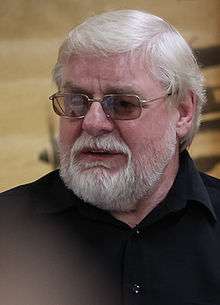Valentin Dikul

Valentin Ivanovich Dikul (Russian: Валентин Иванович Дикуль; born April 3, 1948, Kaunas, Lithuanian SSR, Soviet Union) is a circus artist, Head of the Russian medical and rehabilitation center of the musculoskeletal system diseases. People's Artist of Russia (1999).[1]
Biography
Born in Kaunas premature, weighing just over one kilogram. His father Ivan G. (1920-1950) was shot dead by bandits, when he was 30 years old, and his mother Anna Korneevna (1925-1952), died at age 27, when Valentin still went to kindergarten.[2] He was raised to seven years grandparents. With seven years he lived in orphanages, first in Vilnius, then - in Kaunas. In nine years, he became interested in the circus, and helped to put the circus tent, clean the arena, to look after the animals, sweeping, washing the floors.[3]
At fourteen moonlighting motorcycle repair. He engaged in gymnastics, wrestling, weight lifting, equilibrium, acrobatics, juggling, stunts and tricks invented. Write to circus circle in Kaunas club.[2]
Injury
In 1962, when Valentin was almost fifteen, he starred in his first act of air gymnastics at the Sports Palace. The act was performed at an altitude of 13 meters.[2] During one such performance, a steel support cross beam suddenly burst, and Valentin fell from 13 meters. He spent a week in intensive care at the City Hospital, and was then transferred to the neurosurgery department of the hospital ward. His final diagnosis was a compression fracture of the lumbar spine and traumatic brain injury, with many local fractures.[2]
Recovery
Dikul began to train. Lift objects, stretched rubber band, push-ups. He worked for 5–6 hours a day, but my legs did not work. Suffering pain in the spine and fatigue, he performed strength exercises and studied the medical literature on the spine, gathering the necessary information. Doctors asked him to stop wasting time and effort, explaining that success is impossible. But he continued to exhaustion. He began to lift weights - small at first, then more and more increased weight, develops all the muscles of the back, which were capable. Then he had the idea that you need to move and inactive parts of the body, as if they were healthy - a full cycle.[4] Tied to a rope and feet, passing under the headboard, which played the role of the block, pulling for them - moving the feet. Then he began to be used as a counterweight loads. Friends helped establish over the bed under the scheme system of blocks, painted Dikul. Eight months later he was discharged from the hospital with the first group of disability.[2]
A series of publications in the press provoked an avalanche of letters Dikulja with requests for help. In response, he would send them a package of measures designed for medical rehabilitation. In processing a large amount of correspondence he helped his wife Lyudmila.
Many people confined to a wheelchair, saw it as their hope. Daily Valentin singled out for three to four hours on the advice of people with disabilities.[5]
Russian rehabilitation center patients with spinal injuries and consequences of infantile cerebral paralysis was opened in 1988 - Dikul Center.[5]
References
External links
| Wikimedia Commons has media related to Valentin Dikul. |
- 60 упражнений Валентина Дикуля + Методы активизации внутренних резервов человека = ваше 100% здоровье
- Московские центры В. И. Дикуля